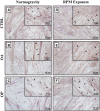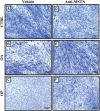Role of Myostatin in Muscle Degeneration by Random Positioning Machine Exposure: An in vitro Study for the Treatment of Sarcopenia
- PMID: 35185612
- PMCID: PMC8853288
- DOI: 10.3389/fphys.2022.782000
Role of Myostatin in Muscle Degeneration by Random Positioning Machine Exposure: An in vitro Study for the Treatment of Sarcopenia
Abstract
Several scientific evidence have shown that exposure to microgravity has a significant impact on the health of the musculoskeletal system by altering the expression of proteins and molecules involved in bone-muscle crosstalk, which is also observed in the research of microgravity effect simulation. Among these, the expression pattern of myostatin appears to play a key role in both load-free muscle damage and the progression of age-related musculoskeletal disorders, such as osteoporosis and sarcopenia. Based on this evidence, we here investigated the efficacy of treatment with anti-myostatin (anti-MSTN) antibodies on primary cultures of human satellite cells exposed to 72 h of random positioning machine (RPM). Cell cultures were obtained from muscle biopsies taken from a total of 30 patients (controls, osteoarthritic, and osteoporotic) during hip arthroplasty. The Pax7 expression by immunofluorescence was carried out for the characterization of satellite cells. We then performed morphological evaluation by light microscopy and immunocytochemical analysis to assess myostatin expression. Our results showed that prolonged RPM exposure not only caused satellite cell death, but also induced changes in myostatin expression levels with group-dependent variations. Surprisingly, we observed that the use of anti-MSTN antibodies induced a significant increase in cell survival after RPM exposure under all experimental conditions. Noteworthy, we found that the negative effect of RPM exposure was counteracted by treatment with anti-MSTN antibodies, which allowed the formation of numerous myotubes. Our results highlight the role of myostatin as a major effector of the cellular degeneration observed with RPM exposure, suggesting it as a potential therapeutic target to slow the muscle mass loss that occurs in the absence of loading.
Keywords: muscle degeneration; myostatin; random positioning machine; sarcopenia; satellite cells.
Copyright © 2022 Cariati, Scimeca, Bonanni, Triolo, Naldi, Toro, Marini, Tancredi, Iundusi, Gasbarra and Tarantino.
Conflict of interest statement
The authors declare that the research was conducted in the absence of any commercial or financial relationships that could be construed as a potential conflict of interest.
Figures




Similar articles
-
Effects of Simulated Microgravity on Muscle Stem Cells Activity.Cell Physiol Biochem. 2020 Aug 5;54(4):736-747. doi: 10.33594/000000252. Cell Physiol Biochem. 2020. PMID: 32749090
-
Bone Morphogenetic Proteins and myostatin pathways: key mediator of human sarcopenia.J Transl Med. 2017 Feb 15;15(1):34. doi: 10.1186/s12967-017-1143-6. J Transl Med. 2017. PMID: 28202082 Free PMC article.
-
Sarcopenia: a histological and immunohistochemical study on age-related muscle impairment.Aging Clin Exp Res. 2015 Oct;27 Suppl 1:S51-60. doi: 10.1007/s40520-015-0427-z. Epub 2015 Jul 22. Aging Clin Exp Res. 2015. PMID: 26197719
-
Myostatin and muscle atrophy during chronic kidney disease.Nephrol Dial Transplant. 2021 Nov 9;36(11):1986-1993. doi: 10.1093/ndt/gfaa129. Nephrol Dial Transplant. 2021. PMID: 32974666 Review.
-
Myostatin--the holy grail for muscle, bone, and fat?Curr Osteoporos Rep. 2013 Dec;11(4):407-14. doi: 10.1007/s11914-013-0160-5. Curr Osteoporos Rep. 2013. PMID: 24072591 Review.
Cited by
-
Whole Body Vibration Improves Brain and Musculoskeletal Health by Modulating the Expression of Tissue-Specific Markers: FNDC5 as a Key Regulator of Vibration Adaptations.Int J Mol Sci. 2022 Sep 8;23(18):10388. doi: 10.3390/ijms231810388. Int J Mol Sci. 2022. PMID: 36142305 Free PMC article.
-
Microgravity and Musculoskeletal Health: What Strategies Should Be Used for a Great Challenge?Life (Basel). 2023 Jun 21;13(7):1423. doi: 10.3390/life13071423. Life (Basel). 2023. PMID: 37511798 Free PMC article. Review.
-
Trolox and recombinant Irisin as a potential strategy to prevent neuronal damage induced by random positioning machine exposure in differentiated HT22 cells.PLoS One. 2024 Mar 21;19(3):e0300888. doi: 10.1371/journal.pone.0300888. eCollection 2024. PLoS One. 2024. PMID: 38512830 Free PMC article.
-
Osteosarcopenia and Long-COVID: a dangerous combination.Ther Adv Musculoskelet Dis. 2022 Oct 26;14:1759720X221130485. doi: 10.1177/1759720X221130485. eCollection 2022. Ther Adv Musculoskelet Dis. 2022. PMID: 36317068 Free PMC article. Review.
-
Control of muscle satellite cell function by specific exercise-induced cytokines and their applications in muscle maintenance.J Cachexia Sarcopenia Muscle. 2024 Apr;15(2):466-476. doi: 10.1002/jcsm.13440. Epub 2024 Feb 20. J Cachexia Sarcopenia Muscle. 2024. PMID: 38375571 Free PMC article. Review.
References
LinkOut - more resources
Full Text Sources
Miscellaneous

